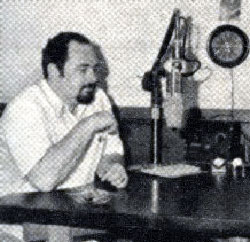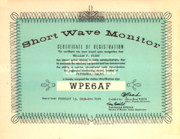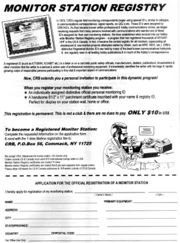Tom Kneitel
From HFUnderground
Tom Kneitel, W4XAA, K2AES, SK (1933-2008)
As a teenager growing up in New York City, Tommy operated an AM pirate station known as WISP. During a DX test in 1949, he received reception reports as far away as Ohio. Later he became the first, and only, journalist to visit Swan Island and Radio Americas, and his article about the journey appeared in the July, 1968 issue of Electronics Illustrated. According to Art, N2AH, Tom actually operated an amateur radio station from Swan Island as KS4CH. The article hit newsstands at almost exactly the same time Radio Americas left the air!
Kneitel was Editor of Popular Communications from its launch in 1982 until 1995, when he gave up day-to-day responsibilities for the magazine and became Senior Editor. He served as an advisor and resource to his successors until recently before his passing. In addition to innumerable articles in Popular Communications, he also published numerous radio and DX related articles in "Popular Electronics", "S9" and "CB Horizons". Occasionally he used the pen name "Alice Brannigan".
He also owned the small publishing house CRB Research Books, Inc, in Commack, NY, which published most of his books in the 1980s and 1990s.
Kneitel was inducted into the CQ Amateur Radio Hall of Fame in 2004.
Contents |
Books by Tom Kneitel
Kneitel had authored a multitude of books on DXing, CB, scanning and other radio-related topics, most of them published by CRB Research Books, Inc, in Commack, NY. This is an incomplete list of his books:
- Electronic circuits handbook (1963)
- Tom Kneitel & Robert M. Mendelson: "103 simple transistor projects", Hayden Book Co, ISBN 0810-40952-1 (1964)
- Surplus conversion handbook, including "command sets" (1967)
- Robert M. Brown & Tom Kneitel: "49 Easy Entertainment & Sience Projects", Howard W. Sams & Co., Inc (1969)
- Tom Kneitel: "CBers' SSB handbook", Hayden Book Co, ISBN 0810-40857-9 (1977)
- The "top secret" registry of U.S. Government radio frequencies, 25 to 470 MHZ (1979-1986)
- Air-scan directory of aero band scanner frequencies (1981)
- Tom Kneitel & Robert M. Brown: "101 Easy Test Instrument Projects", TAB Books, ISBN 0-830613397 (1981)
- Tom Kneitel: "Rail-scan Directory of railroad scanner frequencies", CRB Research, ISBN 0-939780-12-7 (1982)
- National directory of survival radio frequencies (1982)
- Tom Kneitel: "Air Scan Guide to Aeronautical Communications" (4th ed), CRB Research, ISBN 0-939780-03-8 (1984)
- Radio station treasury, 1900-1946 (1986)
- Tom Kneitel: "Guide to embassy & espionage communications", CRB Research, ISBN 0939780062 (1986)
- Tune in on Telephone Calls (1988)
- Tomcat's Big CB Handbook (1988)
- Tom Kneitel: "Directory of U. S. Army Forts, Camps, and Airfields 1789 to 1945", CRB Research, ISBN 093978016X (1992)
Monitor Registration Program
Tom Kneitel run the WPE Monitor Registration Program of Popular Electronics during the late 1950s until 1961.(1)
Later, after the cancellation of the WPE registration service run by Hank Bennet(3), Kneitel launched a similar program through his company CRB Research as the Monitor Station Registry.(2) The CRB registration scheme also issued callsign-like identifiers, following the tradition of WR0, WPE and WDX schemes. Prefixes started with letter "K", followed by two letters indicating the State and a digit according to the amateur radio US prefix areas, so a DXer in New York would have an identifier starting with KNY2 while a DXer in California one starting with KCA6.
| Tom Kneitel on the WPE monitor registration program:
Here's a little background on the program's early days.[1] Originally, during the mid-1950's, a DX'er named Joe P. Morris was issuing SWL ID's with a WR0 prefix. For an SASE, you got a mimeographed strip with only an ID, which was written in by hand. As time went on, Roberts decided it required more time and effort than he had available. He was asking around if anyone was interested in taking it over. I volunteered. At that time I was writing for Popular Electronics, and asked Perry Ferrell, the editor, if they would like to sponsor the project as a service to readers. They agreed and said they would publicize it as a Popular Electronics program, print up the certificates, etc. I was put in charge of the project and my signature was printed on the certificates. We also decided to reorganize the project and replace the WR0 with WPE. The original run of certificates had pre-printed ID's running from WPE1AA through WPE0ZZ. I believe they announced the project late in the 1950's and the response was overwhelming. I processed the applications and typed in the names and dates. It didn't take long for me to run through all of the certificates. The next batch of certificates (to cover ID's with 3-letter suffixes) did not have pre-printed ID's. We did not keep records as to the specific ID assignments. I typed in the ID's, names, dates on those certificates. I handled this program until the spring of 1961 when I became the editor of another radio magazine. At that time, Popular Electronics redesigned the WPE certificate, removed my signature, and replaced it with those of Perry Ferrell and of Hank Bennett, the DX editor of Popular Electronics. I don't know much about the program after that but I know it existed for a number of years. I believe the WDX program came later and was run by a radio club and did not have any any connection with either WPE or Popular Electronics. Hope that's of interest and use. 73, Tom Kneitel, K2AES/ WPE2AB |
Notes and references
- In April 1961 Kneitel left Popular Electronics to become Editor of Horizons Publications (CB/DX'ing Horizons Magazine).
- Jerome S. Berg: "Listening on the short waves, 1945 to today", McFarland, ISBN 0786439963, page 361, 2008.
- After leaving Popular Electronics, Bennet took over the WPE program using his own resources, as the WDX registration service, which, according to John Herkimer, was still active in 2000.
External links
- John Herkimer: "The "WPE" Monitor Registration Program"
- ARRL: "Prolific Author Tom Kneitel, W4XAA SK" (2008-08-25)
This site is a participant in the Amazon Services LLC Associates Program, an affiliate advertising program designed to provide a means for sites to earn advertising fees by advertising and linking to Amazon.com. Some links may be affiliate links. We may get paid if you buy something or take an action after clicking one of these.



